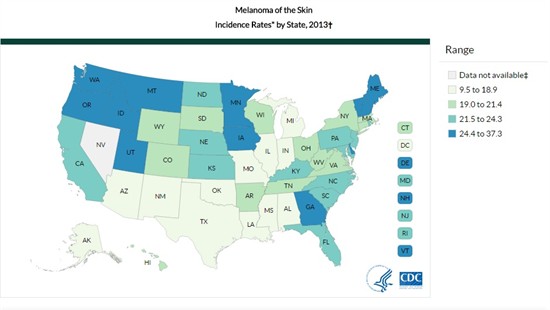Another week of clinic and class is behind me. My colleagues and I did another set of X-rays in Radiographic Positioning but this time we were taking X-rays of the thoracic spine. We set up three views on one another but only captured two on the models. We set up for Anterior to Posterior, Lateral, and Swimmer’s Lateral. Swimmer’s Lateral is only indicated if the patient presents with upper thoracic or lower cervical spine pain, so it isn’t used as often because it is more of a spot view. We also had to write a case report in Radiology Report Writing.
We also had a quiz in dermatology on hyperpigmented lesions. I got a 90% on the quiz, which was fine by me.
While learning about hyperpigmented lesions, we discussed melanoma, the most common type of skin cancer. We talked about the appearance, diagnosis, and conventional medical treatment of melanoma, which is usually removal and biopsy.
The most fascinating part of the lecture was the differing incidence of melanoma throughout the United States. Two things that are associated with melanoma are sun exposure and chemical exposure. In the first class, we talked about chemicals in sunscreens that we should avoid such as oxybenzone. There is inconsistent evidence about the chemicals in sunscreen and their effects on the body, but there is a fear of a carcinogenic effect and there is evidence of altered systemic hormone levels after application.
Through my own research, I found oxybenzone is rapidly oxidized after sun exposure. Oxidation is a damaging process, which is why we need plenty of antioxidants from natural foods like fruits and vegetables. Instead of chemical based sunscreens, one should use a mineral based sunscreen that isn’t absorbed through the skin such as zinc oxide. Finally, the most fascinating part of what I learned about melanoma is that the incidence is highest in states with weaker UV indexes and less year round sun exposure. According to the CDC, Utah, Delaware, Vermont, and Idaho have the highest incidences of melanoma in the United States. Maine, Washington, Oregon, Iowa, New Hampshire, Minnesota, and Montana all have higher incidences than sunny Florida, Texas, and California.

https://www.cdc.gov/cancer/skin/statistics/state.htm
From the data above, one could theorize it isn’t cumulative sun exposure that causes skin cancer but more likely inconsistent exposure. Our bodies produce melanin when exposed to the UV rays emitted from the sun. Melanin serves as a natural sunscreen as it reduces the amount of radiation one can absorb through the skin. The higher amount of melanin is the reason people of darker complexions have a lower incidence of skin cancer.
The other theory is vitamin D is immunoprotective and the constant absorption of vitamin D in sunnier states could be protective against skin cancer. Research has shown vitamin D deficiency is associated with some types of cancers. It is plausible skin cancer may also be associated. It has been noted that people who live above the 37th parallel line in the U.S. are less likely to achieve adequate levels of vitamin D from sun exposure during the colder months.

http://www.health.harvard.edu/staying-healthy/time-for-more-vitamin-d
If one was to look at the two maps, one would see 11 of the 12 states with the highest incidence of melanoma are above the 37th parallel. I think the increased incidence above the 37th parallel is a combination of inconsistent sun exposure, vitamin D deficiency, and chemical sunscreens. When I lived up north, people would get an average of three months of consistent sun exposure. We would get really dark tans and then become extremely pale in the cold winter months. I think the inconsistent flux of melanin production may also be a culprit, rather than consistently producing a small amount of melanin throughout the year like most people in Florida. It is polarized in the northern states. It is basically all or nothing.
If people with darker complexion have a lower risk of skin cancer than people with lighter skin, it may be the melanin production process itself. It is a class I didn’t think I would take as a chiropractor and it is a topic I never gave much thought. I may never have known had it not been for another fantastic lesson from the brilliant faculty at NUHS.
That’s all for this week. Please email me at [email protected] if you have any questions about NUHS.




0 Comments